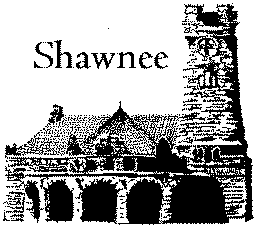
Forgotten Hub of Central Oklahoma
Preface | Early
History | Down Town | Residential | Scenes

Forgotten Hub of Central Oklahoma
The following historical data has been compiled from a publication of the Historical Society of Pottawatomie County. The book the data was compiled from was funded in part by the City of Shawnee.
NOTE: The following Shawnee history is currently being placed online as a side project. Information should continue to be added to the page as staff time allows.
<% ConnectFilter = "HISTORY" %>This publication is not intended to be a complete listing of all the historic properties in Shawnee, Oklahoma. The purpose is to present an overview of the city's history and to identify some of the key historic resource the distinctive architectural features as well as explain the key reasons these neighborhoods developed as they did.
The influence of Shawnee's principal industry, the railroad shops, is assessed, along with the impact of the Oklahoma oil boom in the 1920s on residential construction. The importance of the streetcar system also is analyzed as a factor in the spatial development of Shawnee.
The booklet this site was created from was the result of a planning and survey grant from the Historic Preservation Office of Oklahoma and the City of Shawnee. The director of the survey was Dr. Dale Soden, professor of history at Oklahoma Baptist University. He was assisted by Dr. Gary Farley and Steve Hicks. Additional thanks are due Margaret Soden, Dan Fields, Amy Madison, Kathy Palen, Steve Mosley, and students at Oklahoma Baptist University. Many of the photographs are courtesy of the Shawnee News-Star.
The survey of Shawnee's historical resources was conducted between February 1984 and
May 1985. Supervised by Dr. Soden and Dr. Farley, several students from Oklahoma Baptist University provided extensive photographic coverage of Shawnee's residential construction, as well as many hours of oral interviews with longtime Shawnee residents.
The downtown core has been intensively studied and the state preservation office has been provided with survey data on each of the structures. Additional products of the survey have been the nomination of several structures to the National Historic Register and the addition of a number of structures to the Oklahoma Landmarks Inventory. The City of Shawnee has been provided with photographic evidence of approximately 3,500 structures that are more than 50 years old in the city.
The book was an additional product of the survey and is intended to be a summary review of the resources in the downtown core and the residential districts .
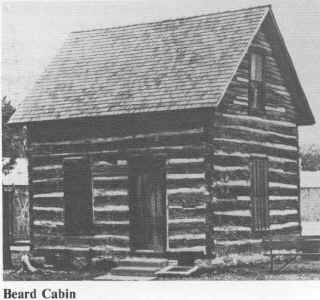 The
area surrounding Shawnee was settled after the Civil War by a number of tribes
that the federal government had removed to Indian Territory. The Sac and Fox
originally were deeded land in the immediate area but were soon followed by the
Kickapoo, Shawnee, and Pottawatomi Indians.
Members of the tribes continue to reside today in and around Shawnee.
The
area surrounding Shawnee was settled after the Civil War by a number of tribes
that the federal government had removed to Indian Territory. The Sac and Fox
originally were deeded land in the immediate area but were soon followed by the
Kickapoo, Shawnee, and Pottawatomi Indians.
Members of the tribes continue to reside today in and around Shawnee.
Over the course of the 1870s, Texas cattle drovers pushed their herds across Indian Territory; there were four major trails, with the West Shawnee trail crossing near present-day Kickapoo and Main Streets. With the cattle drives came railroads; as a result, pressure began to build to allow permanent white settlements in a region that previously had been reserved by treaty to native Americans. The one other event that foreshadowed the coming of white civilization was the establishment in 1871 of the Quaker mission near the current Mission Hill Hospital, where an old building still marks the spot. That first missionary, Joseph Newsom, opened a school in 1872, and by 1876 a post office and trading post had been established a quarter mile west of the mission at what became known as Shawnee Town.
Beginning in April 1889, the United States government succumbed to the pressure that had built to open Indian lands to white settlement. Land runs were initiated after tribal property was seized and then allotted individually to tribal members. At high noon on September 22, 1891, Etta B. Ray, John and Lola Beard, J. T. Farrall, and Elijah Ally set off for the site of present-day Shawnee. By Christmas 1891, John Beard had decided that railroads would be the key to Shawnee's success, and so with the aid of other settlers he made overtures to various railroads. The task was considerable since Tecumseh already had been named the county seat. Nevertheless, by the fall of 1894, the Choctaw Railroad was committed to come through Shawnee. Tracks were completed for Oklahoma City to Shawnee on July 4, 1895. I February 1896, terminal facilities for the Choctaw Railroad were built in Shawnee, but it was the decision of the Choctaw to relocate its main repair shops, which formerly had been McAlester, that served to promote significant growth. The shops provided a strong employment base for the city as the work force soon reached nearly 1,000.
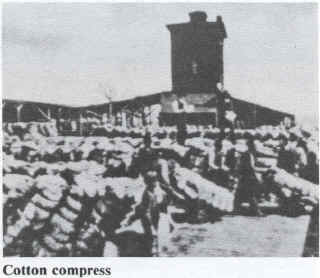 For
the first few years of the new century, Shawnee was in the midst of a boom that
came close to keeping pace with Oklahoma City's. Located in the heart of cotton,
potato, and peach country, Shawnee quickly became an agricultural center.
Reportedly, Shawnee had the largest cotton-seed oil mill in the Southwest. By
1902, there were seven cotton gins in the immediate area and two cotton
compresses. Between March 1901 and March 1902, 375 railroad cars of cotton
product were shipped out of Shawnee, along with 150,000 bales of cotton. Feed
stores, wagon yards, an overall factory, and an assortment of other businesses
designed to serve the farmer as he brought his crop to market sprung up in
Shawnee.
For
the first few years of the new century, Shawnee was in the midst of a boom that
came close to keeping pace with Oklahoma City's. Located in the heart of cotton,
potato, and peach country, Shawnee quickly became an agricultural center.
Reportedly, Shawnee had the largest cotton-seed oil mill in the Southwest. By
1902, there were seven cotton gins in the immediate area and two cotton
compresses. Between March 1901 and March 1902, 375 railroad cars of cotton
product were shipped out of Shawnee, along with 150,000 bales of cotton. Feed
stores, wagon yards, an overall factory, and an assortment of other businesses
designed to serve the farmer as he brought his crop to market sprung up in
Shawnee.
Shawnee's growth was fueled by the railroad industry. By 1902, the Choctaw had been absorbed by the Rock Island, and a station was built at the foot of Union Street. Shortly thereafter, the Santa Fe built one of the more striking stations in the entire country. The Missouri, Kansas, and Texas Railroad, better known as the Katy, also built a station. By 1907, according to the Chamber of Commerce, there was an average of 42 passenger trains and 65 freight trains arriving in the city each day.
Virtually cupped on three sides by railroad tracks, Shawnee developed its commercial activity around Main Street. With no central square around which to build, retail businesses, garment factories, hotels, cotton gins, convention halls, opera houses, and banking institutions jockeyed for the best position on Main Street and its intersecting arterials. By 1903, the streetcar system was being constructed by a private developer. Tracks stretched from St. Benedict's on Kickapoo up to Broadway at Main. Tracks also ran down the middle of Broadway and turned left on Georgia to make a stop near Oklahoma Baptist University. Another line went east on Main to Pesotum and on to turn around at the country club.
While Shawnee did not possess a town square to focus public activity, the city did have Woodland Park, just two blocks north of Main Street. Constructed with fountains and formal gardens, the park was the building location in 1905 of the Carnegie Library, as well as the site of frequent Chautauqua meetings led by such people as William Jennings Bryan. But it was Benson Park, located approximately midway between Shawnee and Tecumseh, that served the recreational needs of Shawnee residents for most of 30 years. What made the park something special was the interurban streetcar that ran between the two towns to the park. Opened in 1907, the park had a swimming pool, skating rink, roller coaster, and large picnic areas.
By 1910, however, it was increasingly clear that while Shawnee would continue to prosper , the city could no longer vie with Oklahoma City for predominance in the region. Shawnee was unsuccessful in attracting the Armour meatpacking company and the Frisco Railroad, and the city came in a distant third in the statewide election to determine the permanent site of the state capital. The city, however, was successful in securing both the Baptist university and a Catholic college, St.Gregory's. But between 1910 and 1920, the population increased at a slowed pace from 12,500 to 15,400.
Shawnee's next growth spurt occurred in the 1920s with the onset of the Oklahoma oil boom. Shawnee was located close enough to Earlsboro and Seminole to benefit substantially from the new wealth, but because there was little oil in the immediate vicinity, the city did not suffer from an uncontrollable growth. At the peak of production, Pottawatomie County wells were producing more than 120,000 barrels a day. The Chamber of Commerce advertised itself as "The Hub of the World's Largest Oil Fields." This oil boom stimulated residential construction, oil-related businesses, and the entertainment industry.
However, there was a number of negative economic factors in the 1920s that ultimately meant Shawnee would suffer significantly during the Depression. In 1922, the Rock Island experienced a nation-wide strike that resulted in increased tension between strikers and strike breakers. While the economic effect of the strike is difficult to evaluate, the shops ceased to grow as an employer in the city. Perhaps more serious was the decline in agricultural production due in large part to the impact of the boll weevil on the cotton crop.
Ultimately, however, it was the stock market crash and the resulting depression that took a great toll on Shawnee residents, as with the rest of the nation. Shawnee's survival depended upon many factors, but clearly one of the more important was the assistance provided by the New Deal. Funding from the federal government helped construct the new county courthouse, the municipal auditorium, the municipal swimming pool, the high school football stadium, the Deer Creek reservoir, and a number of elementary schools. These programs helped soften the blow in 1937 of the loss of the Rock Island repair shops to El Reno.
The Second World War, and in particular the construction of Tinker Air Field east of Oklahoma City, benefited Shawnee's economy. At various times, Tinker has employed as many as 3,000 Shawnee residents. After the war, three major manufacturing concerns were important for Shawnee's economic health. Jonco, Inc., manufactured aviation products and employed nearly 1,000 in 1958. The Sylvania Corporation produced tubes and electrical parts in its Shawnee plant and employed another 1,000. The Shawnee Milling Company, which had rebuilt after a fire in the 1930s, employed nearly 300 workers.
Fairly stagnant until the 1970s, Shawnee's economic climate improved with the addition of a number of industrial plants north of the city which added approximately 1,000 jobs to the community base.
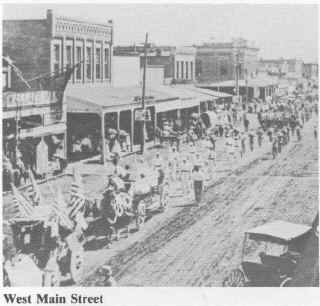 It
is an excellent example of many Main-Street communities that emerged in the late
19th century as part of the westward movement. Choosing not to organize its
activity around a central square, as did many towns in New England, the South,
and upper-Midwest, Shawnee represents a distinctly western model of urban
development. Depending on railroad lines for its economic health, Shawnee's Main
Street became the focal point for commercial, manufacturing, and entertainment
activity beginning in 1895, four years after the region was opened for white
settlement in a land run. Competing with Oklahoma City in order to be the hub of
central Oklahoma, Shawnee developed a fairly broad base of economic activity. As
late as 1910, city leaders hoped that one more rail line, a meat- packing plant,
and the state capital might be just enough to surge ahead of its rival 40 miles
to the west. Such was not the case, however, as Shawnee came in a distant third
in the state- wide election to determine the capital, and lost both the rail
line and the meatpacking plant to Oklahoma City. The setbacks perhaps insured,
however, that Shawnee would be primarily a small city built around the activity
of Main Street.
It
is an excellent example of many Main-Street communities that emerged in the late
19th century as part of the westward movement. Choosing not to organize its
activity around a central square, as did many towns in New England, the South,
and upper-Midwest, Shawnee represents a distinctly western model of urban
development. Depending on railroad lines for its economic health, Shawnee's Main
Street became the focal point for commercial, manufacturing, and entertainment
activity beginning in 1895, four years after the region was opened for white
settlement in a land run. Competing with Oklahoma City in order to be the hub of
central Oklahoma, Shawnee developed a fairly broad base of economic activity. As
late as 1910, city leaders hoped that one more rail line, a meat- packing plant,
and the state capital might be just enough to surge ahead of its rival 40 miles
to the west. Such was not the case, however, as Shawnee came in a distant third
in the state- wide election to determine the capital, and lost both the rail
line and the meatpacking plant to Oklahoma City. The setbacks perhaps insured,
however, that Shawnee would be primarily a small city built around the activity
of Main Street.
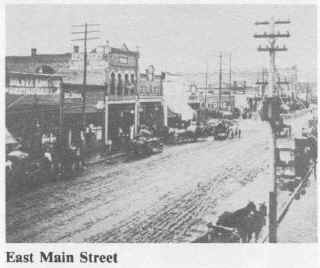 Shawnee's early economic success was developed around the railroad industry. The Santa Fe Train Depot (still extant), with its unique architecture, serves as a visible reminder of the city's dependence on the train. During the early 20th century, the Rock Island Railroad and the Missouri, Kansas, and Texas Railroad both had depots in the city. Shawnee's major employer was the Rock Island Railroad, which had
located its main southwestern repair shops in the city in 1896; the shops were removed to El Reno in 1937, but two major buildings remain. The Santa Fe Railroad also had repair shops just south of the city; only a large concrete tower
remained until 2000 when it was removed.
Shawnee's early economic success was developed around the railroad industry. The Santa Fe Train Depot (still extant), with its unique architecture, serves as a visible reminder of the city's dependence on the train. During the early 20th century, the Rock Island Railroad and the Missouri, Kansas, and Texas Railroad both had depots in the city. Shawnee's major employer was the Rock Island Railroad, which had
located its main southwestern repair shops in the city in 1896; the shops were removed to El Reno in 1937, but two major buildings remain. The Santa Fe Railroad also had repair shops just south of the city; only a large concrete tower
remained until 2000 when it was removed.
Serving as the region's agricultural hub during much of the first quarter of the 20th century, Shawnee provided the markets for significant numbers of farmers to sell their crops. Cotton was a major crop and Main Street was often lined with bales; mule sellers, peanut vendors, and peach growers all came to Shawnee. The building which was reputed to be the largest cotton-seed oil mill in the Southwest is still extant; this same building later was turned into a peanut factory. Seven cotton gins could be found in the city, including the first electric gin in the state, which is still extant. The Shawnee Flouring Mill has been a major part of the city's economic history and still dominates the skyline of the downtown core. The existing building was rebuilt after a fire in 1934. Near Main Street are a coal gasification plant that dates to 1907 and a grain elevator that dates to the 1920s.
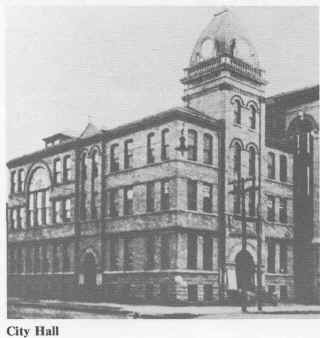 As
of 1980 Main Street was dominated by small retail establishments of which
approximately 80 percent are housed in buildings that were built prior to
statehood in 1907. The large majority of these buildings have had their facades
significantly altered in order to adjust to the changing tastes in the 20th
century. Yet there is one block that remains substantially unaltered from the
turn of the century. This block serves as a living reminder of how life on Main
Street functioned prior to statehood; the buildings still house a hardware
store, a western wear store, and a furniture store. On another block further
west stands, in virtually unaltered condition, Shawnee's most famous department
store, which was constructed in 1907. Acknowledged throughout the region as the
finest of its kind, the Mammoth (currently Neal's Home Furnishings) continues to
remind residents of the high level of retail activity of early Shawnee
residents. Before World War II, Main Street had numerous drugstores and soda
fountains that served as the social gathering places for young people. Today,
the Owl Drug, which is in a building that has been a drugstore since 1895,
retains the old fixtures and reminds one of a former way of socializing on Main
Street.
As
of 1980 Main Street was dominated by small retail establishments of which
approximately 80 percent are housed in buildings that were built prior to
statehood in 1907. The large majority of these buildings have had their facades
significantly altered in order to adjust to the changing tastes in the 20th
century. Yet there is one block that remains substantially unaltered from the
turn of the century. This block serves as a living reminder of how life on Main
Street functioned prior to statehood; the buildings still house a hardware
store, a western wear store, and a furniture store. On another block further
west stands, in virtually unaltered condition, Shawnee's most famous department
store, which was constructed in 1907. Acknowledged throughout the region as the
finest of its kind, the Mammoth (currently Neal's Home Furnishings) continues to
remind residents of the high level of retail activity of early Shawnee
residents. Before World War II, Main Street had numerous drugstores and soda
fountains that served as the social gathering places for young people. Today,
the Owl Drug, which is in a building that has been a drugstore since 1895,
retains the old fixtures and reminds one of a former way of socializing on Main
Street.
The variety of resources on and adjacent to Main Street is reflected in two hotels; the first, the Norwood, was built in 1903 and remains substantially unaltered. People through the 1930s would take the train to Shawnee, stay in the Norwood, and shop in the stores on Main Street. The second hotel, the Aldridge, built in 1928, was a result of the wealth and growth generated by the oil boom of the 1920s, as was the four-story Masonic Temple Office Building, which was constructed in 1929. The one other building that was constructed during the height of the oil boom in Shawnee was the State National Bank on Main Street. The bank fell victim to the Depression in the 1930s, but the building currently houses a number of retail businesses and is known as the Mini-Mall.
Main Street always has had a number of entertainment facilities. A convention hall attracted the likes of Sara Bernhardt, and an opera house on Market and Main was the site of many memorable events. The best example still extant is the Ritz Theater, which is the oldest continuously operating theater in Oklahoma in 1980. The city has the Carnegie Library building, which was rebuilt after a fire in the 1920s.
Downtown Shawnee has lost a great many buildings of historical value, but still retains a significant number of resources that continue to provide a living reminder of how Main Street functioned for a great many Americans in the late 19th and early 20th centuries.
To Be Continued...